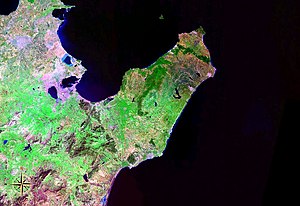Sea battle at Cape Bon (468 AD)
| date | 468 |
|---|---|
| place | at Cape Bon , Tunisia |
| output | vandal victory |
| Parties to the conflict | |
|---|---|
| Commander | |
| Troop strength | |
| approx. 100,000 soldiers 1,100 ships |
|
| losses | |
|
not exactly known |
Unknown |
In the sea battle at Cape Bon ( Promunturium Mercurii ), the allied fleets of the Western Roman and Eastern Roman empires met the Vandal fleet near Carthage under the command of Basiliscus in 468 AD . The invasion of the Vandal Empire was one of the greatest military operations in history; it was an amphibious enterprise and probably had over 1,000 ships and 100,000 soldiers on the Roman side. The aim of the invasion was to punish the Vandal King Gaiserich for sacking Rome in 455 , during which the Empress Licinia Eudoxia (widow of Emperor Valentinian III ) and her daughters were taken hostage. Above all, however, the danger posed by the seafaring vandals should be removed.
background
The project was planned by the Eastern Emperor Leo, the Emperor of the Western Empire Anthemius and General Marcellinus (who enjoyed relative independence in the Illyricum province ). Basiliscus was commissioned to sail straight to Carthage while Marcellinus attacked Sardinia . A third part of the army under Heraclius of Edessa landed on the Libyan coast east of Carthage and advanced rapidly on the city. The combined fleets apparently met in Sicily .
Ancient and modern historians give different figures on the size of the fleet and army of Basiliscus, as well as the costs incurred. Both were extremely high. Theophanes speaks of 100,000 ships, the more reliable Georgios Kedrenos reports of 1,113 ships, each manned by 100 soldiers. In any case, the sources are not very precise and sometimes tend to be very exaggerated. Modern estimates go from around 1,100 ships with 30,000 ( Peter J. Heather assumes this low estimate ) to 100,000 soldiers. In any case, the effort was immense, which underlines the seriousness of the operation.
battle
Sardinia and Libya were already occupied by Marcellinus and Heraclius when Basiliscus dropped anchor at Promontorium Mercurii (today Cape Bon across from Sicily), not far from Carthage. Geiseric asked Basiliscus for five days to negotiate an offer of peace. While the negotiations continued, Geiseric assembled his ships and attacked the Roman fleet. The vandals had filled many ships with combustible material. Under cover of night, these unmanned fires were allowed to drift into the Roman fleet. The Eastern Roman commanders tried to save some ships from the flames, but other Vandal ships hampered their attempts. Basiliscus fled during the battle.
consequences
Half of the Roman fleet burned, was destroyed or conquered by the Vandals, the other half followed Basiliscus. Heraclius retired to Tripolitania , where he held out for two years, until he was recalled; Marcellinus retired to Sicily but was murdered (perhaps at Ricimer's behest ) by one of his own captains; whereupon the Vandal King expressed his surprise and joy that the Romans had got rid of their most capable general.
Basiliscus returned to Constantinople and sought sanctuary in Hagia Sophia to avoid popular anger and the emperor's vengeance. Because of Verina's commitment, Basiliscus was pardoned and only punished with exile to Heraclea Sintica in Thrace.
literature
- Peter J. Heather : The Fall of the Roman Empire: A New History . Macmillan, London 2005, pp. 399ff.
- Andy Merrills, Richard Miles: The Vandals . Blackwell, Oxford / Malden 2010, p. 121f.
